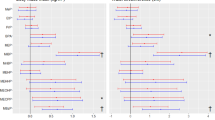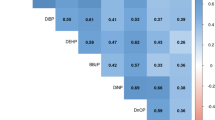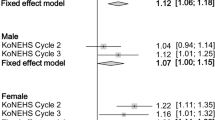Abstract
Objective:
Both bisphenol A (BPA) and phthalates are known endocrine-disrupting chemicals for which there is widespread general population exposure. Human exposure occurs through dietary and non-dietary routes. Although animal studies have suggested a potential role of these chemicals in obesity, evidence from human studies is sparse and inconsistent, and prospective evidence is lacking. This study evaluated urinary concentrations of BPA and major phthalate metabolites in relation to prospective weight change.
Methods:
The study population was from the controls in a prospective case-control study of type 2 diabetes in the Nurses’ Health Study (NHS) and NHSII. A total of 977 participants provided first-morning-void urine samples in 1996–2002. Urinary concentrations of BPA and nine phthalate metabolites were measured using liquid chromatography–mass spectrometry. Body weights were self-reported at baseline and updated biennially thereafter for 10 years.
Results:
On average, the women gained 2.09 kg (95% confidence interval (CI), −2.27 to 6.80 kg) during the 10-year follow-up. In multivariate analysis with adjustment of lifestyle and dietary factors, in comparison with women in the lowest quartile of BPA concentration, those in the highest quartile had 0.23 kg per year (95% CI, 0.07–0.38 kg per year) greater weight gain during the 10-year follow-up (P-trend=0.02). Several phthalate metabolites, including phthalic acid, MBzP and monobutyl phthalate, were also associated with faster prospective weight gain in a dose-response fashion (P-trend<0.01), whereas other phthalates metabolites, including MEP and monoethylhexyl phthalate, were not monotonically associated with body weight change.
Conclusions:
These data suggest urinary concentrations of BPA and certain individual phthalate metabolites that were associated with modestly greater weight gain in a dose-response fashion. These data are consistent with a potential role of BPA and phthalates in obesity, although more prospective data are needed to corroborate these observations.
This is a preview of subscription content, access via your institution
Access options
Subscribe to this journal
Receive 12 print issues and online access
$259.00 per year
only $21.58 per issue
Buy this article
- Purchase on Springer Link
- Instant access to full article PDF
Prices may be subject to local taxes which are calculated during checkout
Similar content being viewed by others
References
Mokdad AH, Serdula MK, Dietz WH, Bowman BA, Marks JS, Koplan JP . The continuing epidemic of obesity in the United States. JAMA 2000; 284: 1650–1651.
Hoyt CL, Burnette JL, Auster-Gussman L . "Obesity is a disease": examining the self-regulatory impact of this public-health message. Psychol Sci 2014; 25: 997–1002.
De Coster S, van Larebeke N . Endocrine-disrupting chemicals: associated disorders and mechanisms of action. J Environ Public Health 2012; 2012: 713696.
Alonso-Magdalena P, Quesada I, Nadal A . Endocrine disruptors in the etiology of type 2 diabetes mellitus. Nat Rev Endocrinol 2011; 7: 346–353.
Crews D, McLachlan JA . Epigenetics, evolution, endocrine disruption, health, and disease. Endocrinology 2006; 147: S4–10.
Hauser R, Calafat AM . Phthalates and human health. Occup Environ Med 2005; 62: 806–818.
Geens T, Aerts D, Berthot C, Bourguignon JP, Goeyens L, Lecomte P et al. A review of dietary and non-dietary exposure to bisphenol-A. Food Chem Toxicol 2012; 50: 3725–3740.
Newbold RR, Padilla-Banks E, Jefferson WN . Environmental estrogens and obesity. Mol Cell Endocrinol 2009; 304: 84–89.
Grun F, Blumberg B . Perturbed nuclear receptor signaling by environmental obesogens as emerging factors in the obesity crisis. Rev Endocr Metab Disord 2007; 8: 161–171.
Bhandari R, Xiao J, Shankar A . Urinary bisphenol A and obesity in U.S. children. Am J Epidemiol 2013; 177: 1263–1270.
Li DK, Miao M, Zhou Z, Wu C, Shi H, Liu X et al. Urine bisphenol-a level in relation to obesity and overweight in school-age children. PLoS One 2013; 8: e65399.
Harley KG, Aguilar Schall R, Chevrier J, Tyler K, Aguirre H, Bradman A et al. Prenatal and postnatal bisphenol A exposure and body mass index in childhood in the CHAMACOS cohort. Environ Health Perspect 2013; 121: 514–520.
Wells EM, Jackson LW, Koontz MB . Association between bisphenol A and waist-to-height ratio among children: National Health and Nutrition Examination Survey, 2003-2010. Ann Epidemiol 2013; 24: 165–167.
Wang HX, Zhou Y, Tang CX, Wu JG, Chen Y, Jiang QW . Association between bisphenol A exposure and body mass index in Chinese school children: a cross-sectional study. Environ Health 2012; 11: 79.
Trasande L, Attina TM, Blustein J . Association between urinary bisphenol A concentration and obesity prevalence in children and adolescents. JAMA 2012; 308: 1113–1121.
Shankar A, Teppala S, Sabanayagam C . Urinary bisphenol a levels and measures of obesity: results from the national health and nutrition examination survey 2003-2008. ISRN Endocrinol 2012; 2012: 965243.
Wang T, Li M, Chen B, Xu M, Xu Y, Huang Y et al. Urinary bisphenol A (BPA) concentration associates with obesity and insulin resistance. J Clin Endocrinol Metab 2012; 97: E223–E227.
Carwile JL, Michels KB . Urinary bisphenol A and obesity: NHANES 2003-2006. Environ Res 2011; 111: 825–830.
Wang H, Zhou Y, Tang C, He Y, Wu J, Chen Y et al. Urinary phthalate metabolites are associated with body mass index and waist circumference in Chinese school children. PLoS One 2013; 8: e56800.
Lind PM, Roos V, Ronn M, Johansson L, Ahlstrom H, Kullberg J et al. Serum concentrations of phthalate metabolites are related to abdominal fat distribution two years later in elderly women. Environ Health 2012; 11: 21.
Hatch EE, Nelson JW, Qureshi MM, Weinberg J, Moore LL, Singer M et al. Association of urinary phthalate metabolite concentrations with body mass index and waist circumference: a cross-sectional study of NHANES data, 1999-2002. Environ Health 2008; 7: 27.
Stahlhut RW, van Wijngaarden E, Dye TD, Cook S, Swan SH . Concentrations of urinary phthalate metabolites are associated with increased waist circumference and insulin resistance in adult U.S. males. Environ Health Perspect 2007; 115: 876–882.
Trasande L, Attina TM, Sathyanarayana S, Spanier AJ, Blustein J . Race/ethnicity-specific associations of urinary phthalates with childhood body mass in a nationally representative sample. Environ Health Perspect 2013; 121: 501–506.
Sun Q, Cornelis M, Townsend M, Tobias D, Eliassen A, Franke A et al. Association of urinary concentrations of bisphenol A and phthalate metabolites with risk of type 2 diabetes: a prospective investigation in the Nurses' Health Study (NHS) and NHSII cohorts. Environ Health Perspect 2014; e-pub ahead of print 14 March 2014; doi:10.1289/ehp.1307201.
Willett W, Stampfer MJ, Bain C, Lipnick R, Speizer FE, Rosner B et al. Cigarette smoking, relative weight, and menopause. Am J Epidemiol 1983; 117: 651–658.
Chiuve SE, Fung TT, Rimm EB, Hu FB, McCullough ML, Wang M et al. Alternative dietary indices both strongly predict risk of chronic disease. J Nutr 2012; 142: 1009–1018.
Fox SD, Falk RT, Veenstra TD, Issaq HJ . Quantitation of free and total bisphenol A in human urine using liquid chromatography-tandem mass spectrometry. J Sep Sci 2011; 34: 1268–1274.
Kato K, Silva MJ, Needham LL, Calafat AM . Determination of 16 phthalate metabolites in urine using automated sample preparation and on-line preconcentration/high-performance liquid chromatography/tandem mass spectrometry. Anal Chem 2005; 77: 2985–2991.
Blount BC, Milgram KE, Silva MJ, Malek NA, Reidy JA, Needham LL et al. Quantitative detection of eight phthalate metabolites in human urine using HPLC-APCI-MS/MS. Anal Chem 2000; 72: 4127–4134.
Melzer D, Osborne NJ, Henley WE, Cipelli R, Young A, Money C et al. Urinary bisphenol A concentration and risk of future coronary artery disease in apparently healthy men and women. Circulation 2012; 125: 1482–1490.
Braun JM, Kalkbrenner AE, Calafat AM, Bernert JT, Ye X, Silva MJ et al. Variability and predictors of urinary bisphenol A concentrations during pregnancy. Environ Health Perspect 2011; 119: 131–137.
Buckley JP, Palmieri RT, Matuszewski JM, Herring AH, Baird DD, Hartmann KE et al. Consumer product exposures associated with urinary phthalate levels in pregnant women. J Expo Sci Environ Epidemiol 2012; 22: 468–475.
Grun F, Blumberg B . Environmental obesogens: organotins and endocrine disruption via nuclear receptor signaling. Endocrinology 2006; 147: S50–S55.
Masuno H, Kidani T, Sekiya K, Sakayama K, Shiosaka T, Yamamoto H et al. Bisphenol A in combination with insulin can accelerate the conversion of 3T3-L1 fibroblasts to adipocytes. J Lipid Res 2002; 43: 676–684.
Wada K, Sakamoto H, Nishikawa K, Sakuma S, Nakajima A, Fujimoto Y et al. Life style-related diseases of the digestive system: endocrine disruptors stimulate lipid accumulation in target cells related to metabolic syndrome. J Pharmacol Sci 2007; 105: 133–137.
Soriano S, Alonso-Magdalena P, Garcia-Arevalo M, Novials A, Muhammed SJ, Salehi A et al. Rapid insulinotropic action of low doses of bisphenol-A on mouse and human islets of Langerhans: role of estrogen receptor beta. PLoS One 2012; 7: e31109.
Heudorf U, Mersch-Sundermann V, Angerer J . Phthalates: toxicology and exposure. Int J Hyg Environ Health 2007; 210: 623–634.
Desvergne B, Feige JN, Casals-Casas C . PPAR-mediated activity of phthalates: a link to the obesity epidemic? Mol Cell Endocrinol 2009; 304: 43–48.
Feige JN, Gelman L, Rossi D, Zoete V, Metivier R, Tudor C et al. The endocrine disruptor monoethyl-hexyl-phthalate is a selective peroxisome proliferator-activated receptor gamma modulator that promotes adipogenesis. J Biol Chem 2007; 282: 19152–19166.
Hurst CH, Waxman DJ . Activation of PPARalpha and PPARgamma by environmental phthalate monoesters. Toxicol Sci 2003; 74: 297–308.
Lee DH, Steffes MW, Sjodin A, Jones RS, Needham LL, Jacobs DR Jr . Low dose organochlorine pesticides and polychlorinated biphenyls predict obesity, dyslipidemia, and insulin resistance among people free of diabetes. PLoS One 2011; 6: e15977.
Lee DH, Steffes MW, Sjodin A, Jones RS, Needham LL, Jacobs DR Jr . Low dose of some persistent organic pollutants predicts type 2 diabetes: a nested case-control study. Environ Health Perspect 2010; 118: 1235–1242.
Townsend MK, Franke AA, Li X, Hu FB, Eliassen AH . Within-person reproducibility of urinary bisphenol A and phthalate metabolites over a 1 to 3 year period among women in the Nurses' Health Studies: a prospective cohort study. Environ Health 2013; 12: 80.
Mahalingaiah S, Meeker JD, Pearson KR, Calafat AM, Ye X, Petrozza J et al. Temporal variability and predictors of urinary bisphenol A concentrations in men and women. Environ Health Perspect 2008; 116: 173–178.
Acknowledgements
We thank Dr Xingnan Li for her skillful performance of the liquid chromatography–mass spectrometry assays. This work is supported by grants U54CA155626, P30 DK46200, CA87969, CA49449, DK58845, DK58785, DK082486, CA50385, CA67262 and CA71789 from the National Institutes of Health (NIH). QS is supported by a career development award R00HL098459 from the National Heart, Lung, and Blood Institute. YS is a recipient of Burroughs Wellcome Fund Inter-school Training Program in Metabolic Diseases at UCLA.
Author information
Authors and Affiliations
Corresponding author
Ethics declarations
Competing interests
The authors declare no conflict of interest.
Additional information
Supplementary Information accompanies this paper on International Journal of Obesity website
Supplementary information
Rights and permissions
About this article
Cite this article
Song, Y., Hauser, R., Hu, F. et al. Urinary concentrations of bisphenol A and phthalate metabolites and weight change: a prospective investigation in US women. Int J Obes 38, 1532–1537 (2014). https://doi.org/10.1038/ijo.2014.63
Received:
Revised:
Accepted:
Published:
Issue Date:
DOI: https://doi.org/10.1038/ijo.2014.63
Keywords
This article is cited by
-
BMI-specific inflammatory response to phthalate exposure in early pregnancy: findings from the TMCHESC study
Environmental Science and Pollution Research (2023)
-
Exposure to Bisphenol A, S, and F and its Association with Obesity and Diabetes Mellitus in General Adults of Korea: Korean National Environmental Health Survey (KoNEHS) 2015–2017
Exposure and Health (2023)
-
Urinary phthalate exposures and risk of breast cancer: the Multiethnic Cohort study
Breast Cancer Research (2021)
-
Exposure to phthalates and cardiovascular diseases in Chinese with type 2 diabetes
Environmental Science and Pollution Research (2021)
-
Exposure to Endocrine Disrupting Chemicals in the Dutch general population is associated with adiposity-related traits
Scientific Reports (2020)



